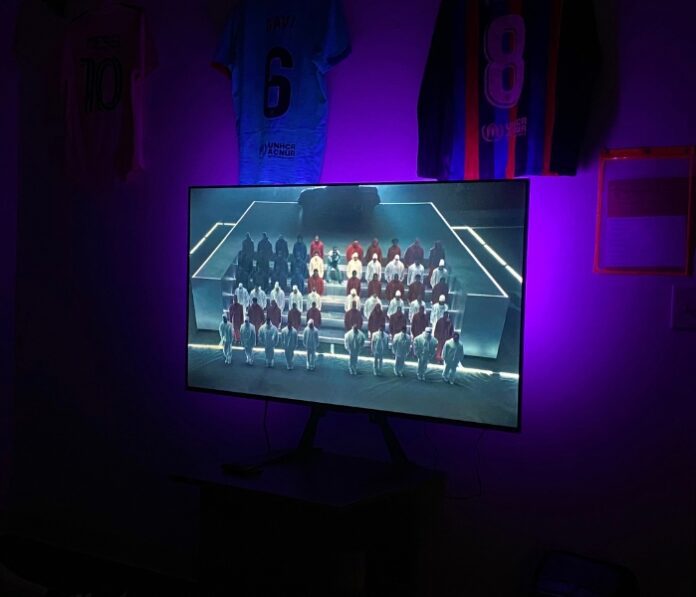Amidst the multiple Grammy, MTV, BET and Billboard musical awards that rapper Kendrick Lamar has been awarded throughout his career, a lesser-known fact about the famous Compton-area musical artist is that he was also awarded the prestigious Pulitzer Prize for Music in 2018.”
With Lamar’s authorship and rhymes being constantly compared to written poetry by fans and critics alike, it’s no surprise that such an honorable award was given to Kendrick. During this Super Bowl LIX, the pure artistry and talent that Lamar encapsulates became even more apparent to the wider public, as was seen with his riveting halftime show.
One of the most cheeky features of Lamar’s performance was the thought put into not just his performance, but the artistry of his fellow performers and the set. Before even showing his face, the set begins with video game sounds, while lights flicker around the field–now divided into a tic-tac-toe board.
Circles, squares and triangles light up in unison with the gameboard, which many believe are referencing the controller buttons found on PlayStation controllers. A commanding and familiar voice is soon heard, and the camera pans to famous actor and former Black Panther member Samuel L. Jackson, dressed in patriotic garb akin to the famous figure of Uncle Sam.
Jackson’s costumed appearance as Uncle Sam was a surprising twist on the famous American symbol most associated with patriotism and military recruitment. Throughout the performance Jackson serves as a commentator, continually chastising Lamar’s actions and songs, labeling them as “…too loud, too reckless, too ghetto.”
These negative interjections relate to the American public’s view of a proper Super Bowl halftime show. As the first solo rapper to ever headline a Super Bowl halftime show, Lamar is inherently breaking long-standing traditions through his set.
Jackson’s Uncle Sam doesn’t just represent a critic in the setting of the performance, but also the wider opinion of the American public’s view on Black music and what a “proper halftime show” should be.
As the concert continued, more references, specifically patriotic and political references, began surfacing. National imagery was present throughout the entirety of the production, as seen with the backup dancer’s loud red, white and blue outfits.
The dancers lined up to form an American flag with their bodies while Lamar performs “Humble,” referencing how America was built off of the labor and bodies of Black enslaved people.
The dancers also stand on cascading stairs while Lamar raps in the middle, creating a divide within the flag, calling back to the divided political landscape that defined American politics these past years.
Also, during one of his later performances, the red, white and blue outfitted dancers fall to the floor with their limbs sprawled around, which references police chalk drawings on sidewalks and that association of violence within Black communities and continuing violence enacted upon Black communities.
Towards the end of the show, before Lamar belts out his award-winning diss track, “Not Like Us,” he makes a tongue-in-cheek joke calling out his rival, Canadian rapper Drake. Some of the most influential and bold lines that Kendrick rapped were at the end of the show, amidst “Not Like Us” and the closing number “TV off.”
The interlude in between the songs “Peekaboo” and “Not Like Us” circles back to the themes of commercialism, fitting into a perceived box, racism and politics that Lamar’s performance had been harping on, as it references reparations that were promised to newly freed Black slaves after the Civil War – promises that were never fulfilled and were ultimately dismantled during the end of Reconstruction and the Presidency of Andrew Johnson.
Once Lamar performs popular, more consumer-friendly pop songs with SZA, Jackson’s Uncle Sam is quick to compliment, stating, “That’s what America wants! Nice, and calm, you’re almost there…”, but this pigeon-holing is not what Lamar wants to promote.
He feels no need to be a perfectly sanitized musical artist who only performs hits to the swaying masses–he is unabashedly bold and vibrant, and triumphs his artistry for rap and Black music.
This ultimately is how Kendrick wins “The Great American Game.” It is due to his refusal to adhere to the traditional standard that he prevails in the end.
After telling the viewer to be aware and present, which many believe is Lamar making a statement about staying politically active during these times of turmoil in America, a bright “Game Over” appears in the sky, signaling the end of the show.
